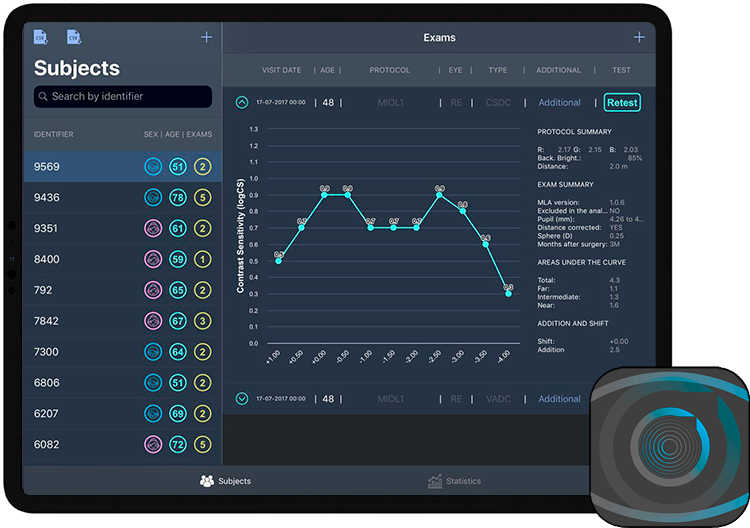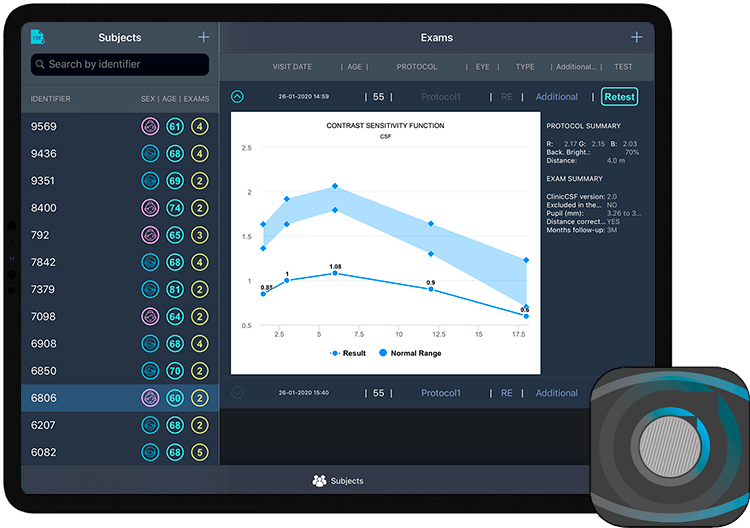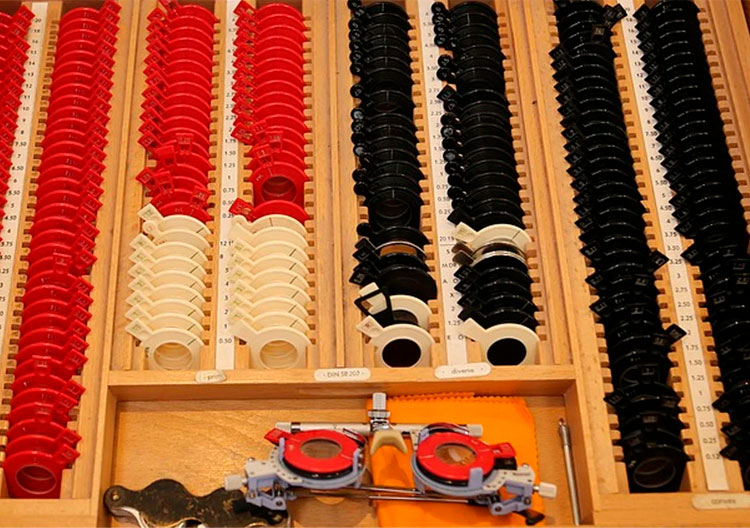Contrast SensitivityWhich test to use in measuring performance with Simultaneous Vision lenses? |
|
|
|
In this lesson, we are going to explain which test to use to evaluate Contrast Sensitivity. We already know from previous lessons that Simultaneous Vision procedures affect high spatial frequencies more. Therefore, whether with optotypes or sinusoidal gratings, we must bear in mind that if we use a test that measures high spatial frequencies, small optotypes, or sinusoidal grating with a high spatial frequency, we will be able to better detect potential changes in optical quality produced by the simultaneous vision optical system. Choosing one or the other, whether an optotype or a sinusoidal grating, if we focus on the Multifocal Lens Analyzer or the ClinicCSF, the former allows us to measure, using a 0.3 logMAR optotype, Contrast Sensitivity at different distances, but only for a basic spatial frequency, which is a high spatial frequency of around 20 cycles per degree. With the Multifocal Lens Analyzer, you will be able to get information at all distances, for example, from far to near in discrete steps, but this information will only be available for a dominant high spatial frequency. Is this a problem? Not really, because most of the time it is the high frequencies that interest us in multifocal procedures. On the other hand, if what interests you is measuring the entire range of spatial frequencies for that multifocal procedure, we have a time limitation. Measuring the Contrast Sensitivity Defocus Curve for a spatial frequency can take approximately the same time as measuring the Contrast Sensitivity Function, but for example, at three specific distances. If the Contrast Sensitivity Function with the ClinicCSF can take us about 2 minutes, and the Contrast Sensitivity Defocus Curve about 7 or 8 minutes, then you would have two alternatives to choose from, investing the same measurement time. The first alternative is to perform a measurement of the Contrast Sensitivity Function at specific distances, for example, the function at three distances, 4 m, 66 cm, and 40 cm. The ClinicCSF is the only test that allows you to configure the protocol based on distance, you choose these three distances and measure the Contrast Sensitivity Function for each of these three distances. Unfortunately, we will not have information at other distances, for example, between 4 meters and 66 cm or distances closer to 40 cm. If you want information at all distances, you have the Multifocal Lens Analyzer, to make a defocus curve for a dominant high spatial frequency. This would take approximately the same time as measuring 3 contrast sensitivity functions at 3 distances. But remember that we are going to lose information about the possible effects of intermediate or low frequencies. In conclusion, which test to use, the ClinicCSF or Multifocal Lens Analyzer? The answer will depend on your objective. If you want to maximize information at one distance or want to have even less information, but over the widest possible range of distances. In the first case, go to the ClinicCSF, evaluating the Contrast Sensitivity Function at a particular distance, and in the second case, use the Multifocal Lens Analyzer, to understand what is the vision over the entire range for a dominant high spatial frequency. |
Blog
Related Articles

Defocus Curves: Fast Measurement with Multifocal Lens Analyzer
Read More
Multifocal Lens Analyzer (MultifocalLA) is a professional APP, useful in the practice of Ophthalmology and Optometry, to measure Visual Acuity Defocus Curve and Contrast Sensitivity Defocus Curve in multifocal procedures (Intraocular Lenses, Contact Lenses and Laser Surgery).

Contrast Sensitivity Test Validated for iPad: ClinicCSF
Read More
ClinicCSF is an application available for iPad and validated to measure Contrast Sensitivity Function at various distances.

Optimum Distance to measure a Defocus Curve
Read More
It is important to take into account that changing optotype size is not the same that correcting vergence by proximal distance. This is a concept that generates confusion as we have seen in many of the courses we have conducted about Defocus Curves.
